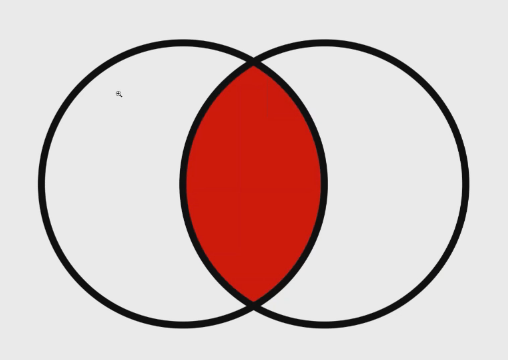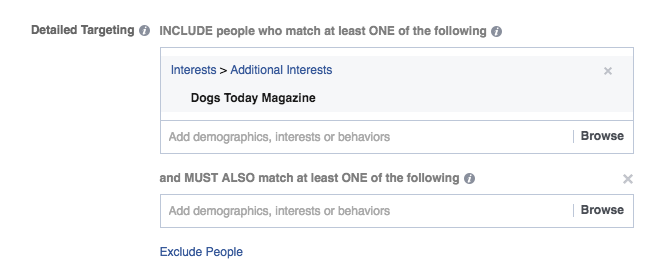Simply put, “flex targeting”, also known as “intersecting” or the “narrow audience tool”, allows you to create laser-focused high-converting Facebook ads, when implemented properly.
Before you go crazy and start creating insanely targeted ads with the information I’m going to give you, here are the prerequisites:
- You have to have a Facebook Ads account
- You have to have something to sell
- You should have already done your niche research and know who you want to target with your ads
Ok, let’s get into it.
The two main uses of flex targeting, and why YOU should implement these right away
The primary use of flex targeting is to simply narrow down your targeted audience in your chosen niche so it most accurately represents your ideal customer (someone who will buy from you).
The second instance in which flex targeting is used is to sell a product which combines two (or more) niches. For example, selling t-shirts to people who are both dog lovers and coffee lovers.
Facebook’s targeting options make this incredibly easy for us to do now and this level of detailed targeting is unparalleled in the business world, today.
Think about the opportunity we now have to put very unique products in front of anyone, products which normal stores do not offer.
(If we wanted to) We could target and sell t-shirts to 50 year old men that are lawyers and have three kids, live in California, like motorcycles, don’t like basketball, and attend yacht club parties on the weekends.
Facebook has given us the means to present people with the most uniquely tailored products that they have self-declared interest in. Talk about a powerful tool at our fingertips!
When you offer such specifically tailored products, you are talking directly to the consumer and this elicits a jaw-dropping reaction, effectively putting them in a buying mindset. You can literally shock people with how well you know what they like!
How does flex targeting actually work? Let’s take a look at the third-grade math diagram below 🙂
Imagine the first black circle on the left is one interest in your niche and the second black circle is another interest in the same niche, and both have an audience of 1 million people on Facebook.

The red oval in the middle represents the overlap between these two audiences, aka: the flex targeting.
A basic Facebook ad would show your ad to one circle or the other circle, but with flex targeting we can effectively reach people who are interested in not one, but two subcategories in the same niche, or multiple interests in the same interest group.
Do you see how much more powerful this is? Good!
If this sounds complicated it’s not.
This is basic marketing – show your ads to the people who (really) want what you have to offer. Flex targeting allows us do this.
Let’s go through an example using the dog niche, assuming we are selling a dog related product:
- Go to your Facebook Ads
- Select “Create Ad”.
- On the Ad Set level under “Detailed Targeting” in the first box, type in “Dogs Today Magazine” (we already did our research so we know all the popular dog magazines).

- Now Facebook will cleverly start suggesting other dog related magazines and interests, select all of the magazines it brings up (and search for any missing ones from your research that haven’t showed up yet).
- Now hover your cursor over all the dog magazines in the first box and find the one with the largest audience size – make a mental note of the name.
- Delete this interest name from the top box and type it into the second box below (hit “Narrow Further” to bring up the second box). This will lower your audience size because now your ad will be showed to people who like ANY of the first box interests (dog magazines) AND the one particular magazine with the largest group of people in it that you just moved to the second box. This is flex targeting.
- Now (if you can) repeat the process of finding the largest group in the top box and putting it in the next “Narrow Further” box below, until your audience size is no lower than 75,000 people (75,000-300,000) is recommended.
The psychology behind the effectiveness of flex targeting
By hitting “Narrow Further” you keep adding the “AND” factor to your Facebook ads, making your audience increasingly more targeted each time.
Essentially, you are prequalifying your target audience to represent the most probable buyers of whatever niche you are in.
Intersecting audiences not only increases your chances of success with your current ad, but will also help you with your future ads.
How so?
…Let’s say you successfully make sales from a flex-targeted audience size of 75,000-300,000 people.
Every person in that audience is going to be much more similar (due to your flex targeting) than an audience size of say the 2.7 million people which you would have had if you didn’t use flex targeting and only typed in one interest in the top targeting box.
Thus, given your theoretical success with the first ad, when you go back to create a new ad for a different product in the the same niche, you can target the same audience and replicate previous success because your audiences are organized in such a way that the people within them are fairly similar in terms of what they are interested in.
This builds consistency into your business model and allows you to strategically test your different interest groups and forecast or predict who will buy certain products in the future.
If you have success with a particular audience chances are you will continue to have success selling them additional products.
With a successful product you can test-run Facebook Ads through an audience size of 100,000 quite easily, and since this audience has proven successful you can simply undo the intersects in the audience and target a much larger audience (this is a basic method of scaling, click here to read more about this).
Make no mistake! You are not limiting your upside with intersecting, you are merely organizing your ad testing in a cost and time efficient manner.
Remember, you should always start with the most targeted possible audience.
These are the people who are most likely to buy from you – if they don’t buy your product then why would someone else buy it, who is less interested?!
Find success in small audiences (75,000-300,000) and then scale to larger ones.
Happy flexing 🙂
